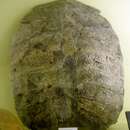Biology
provided by Arkive
This aquatic species lives and feeds in the water, rarely venturing on land, possibly only to nest. Nest cavities are dug 50 to 75 centimetres deep into the river banks, into which 60 to 117 round white eggs are deposited before the rainy season (2). After the eggs have been laid, the female will use her forelimbs to cover them back up with sand (4).
The striped narrow-headed softshell turtle is carnivorous, feeding on fish, prawns, crabs and clams. To catch fish, the neck is rapidly outstretched and the fish seized in the mouth as it swims by (2).
Conservation
provided by Arkive
The striped narrow-headed softshell turtle is given national protection in Indonesia under the law on Conservation of Biological Natural Resources and their Ecosystems, which prohibits utilisation of the species in any form, except with special permission for circumstances such as research or captive breeding. In Thailand, this turtle is specifically protected under the Wild Animals Reservation and Protection ACT (WARPA), which controls hunting, trade, possession, import, export and commercial breeding of wildlife. Furthermore, numerous protected areas with important wetland habitat that may contain this species exist in Indonesia, Malaysia and Thailand, where collecting or disturbance of wildlife is prohibited, although its presence in these protected areas is largely unconfirmed. However, enforcement of protection laws and prevention of encroachment into protected areas are often constrained by lack of resources. Captive breeding projects have been established for this turtle in Thailand, but these have not been successful, with the species so far breeding poorly under captive conditions (6). Thus, it has been advocated that this species, as one of the world's 25 most endangered turtles, should be upgraded to Appendix I of CITES, with prohibitions on hunting for food and the pet trade strictly enforced. Additionally, the formation of protected areas within the species range must continue if there is any chance of winning the battle to save this huge, exquisite, critically endangered turtle (2)
Description
provided by Arkive
This magnificent turtle is one of the largest of all freshwater turtles (2) (4), with a carapace reaching impressive lengths of up to 140 centimetres (2). This species is easily distinguished from other softshell turtles by the exquisite, boldly striped pattern of dark wavy lines on the upper surface of its head, neck, and shell (5). The light brown to yellowish-brown carapace can be rounded or slightly elongated (2) (4), and the plastron is cream-coloured to pinkish-white, without pattern or markings (2) (5). The head is long and narrow, with the eyes close to the tip of the snout (5). Adult males can be distinguished from females and juveniles by their longer, thicker tails (2).
Habitat
provided by Arkive
A freshwater aquatic species preferring large rivers with clear, flowing water and sandy bottoms (5).
Range
provided by Arkive
Now restricted to the Mae Klong basin of western Thailand, the Tahan river basin of Peninsular Malaysia, and the island of Java in Indonesia (5) (6).
Status
provided by Arkive
Classified as Critically Endangered (CR) on the IUCN Red List 2007 (1) and listed on Appendix II of CITES (3).
Threats
provided by Arkive
Like many tortoises and turtles of Southeast Asia, the striped narrow-headed softshell turtle has been intensively exploited and over-collected from the wild for the Asian food market and international pet trade (1). Indeed, adult striped narrow-headed softshell turtles are prized as status symbol pets in Thailand, where commercial-breeding farms have often taken dozens of animals from the wild without producing a single captive-bred hatchling. In addition, the species has suffered badly from habitat destruction caused by deforestation in Indonesia, as a result of conversion into agricultural land, human settlements, logging operations and forest fires (6). In Thailand, river pollution and alteration, including sand dredging and dam and reservoir construction, have also dramatically impacted turtle populations. Striped narrow-headed softshell turtles are now frequently seen in reservoirs or in densely settled downstream river sections, rather than their preferred habitat of clear, fresh-flowing water (2). These combined threats have left the species in a highly precarious position, so much so that, in 2003, it was officially recognised as on of the world's top 25 most endangered turtles (7).
Asian narrow-headed softshell turtle
provided by wikipedia EN
The Asian narrow-headed softshell turtle (Chitra chitra) is a large species of softshell turtle in the family Trionychidae. The species is endemic to Southeast Asia.
Common names
Chitra chitra is also known commonly as Nutaphand's narrowhead softshell.[4]
Description
C. chitra can reach a straight carapace length of 4.9 ft (1.5 m).
Geographic range
C. chitra is found in Indonesia, Malaysia, and Thailand.[5]
Habitat
C. chitra inhabits freshwater rivers and their tributaries.[5]
Reproduction
C. chitra is oviparous.[5] Nutaphand (1986) reported that a large female laid over 100 eggs.
Subspecies
Two subspecies are recognized as being valid, including the nominotypical subspecies.[5]
References
-
^ Cota, M.; Guntoro, J.; As-singkily, M.; Hamidy, A.; Kusrini, M.D. (2019). "Chitra chitra". IUCN Red List of Threatened Species. 2019: e.T4695A152049778. doi:10.2305/IUCN.UK.2019-1.RLTS.T4695A152049778.en. Retrieved 15 November 2021.
-
^ "Appendices | CITES". cites.org. Retrieved 2022-01-14.
-
^ Fritz, Uwe; Havaš, Peter (2007). "Checklist of Chelonians of the World" (PDF). Vertebrate Zoology. 57 (2): 311–312. ISSN 1864-5755. Archived from the original (PDF) on 2011-05-01. Retrieved 29 May 2012.
-
^ Beolens, Bo; Watkins, Michael; Grayson, Michael (2011). The Eponym Dictionary of Reptiles. Baltimore: Johns Hopkins University Press. xiii + 296 pp. ISBN 978-1-4214-0135-5. ("Nutaphand's Narrowhead Softshell Chitra chitra ", p. 192).
-
^ a b c d Species Chitra chitra at The Reptile Database . www.reptile-database.org.
- license
- cc-by-sa-3.0
- copyright
- Wikipedia authors and editors
Asian narrow-headed softshell turtle: Brief Summary
provided by wikipedia EN
The Asian narrow-headed softshell turtle (Chitra chitra) is a large species of softshell turtle in the family Trionychidae. The species is endemic to Southeast Asia.
- license
- cc-by-sa-3.0
- copyright
- Wikipedia authors and editors

